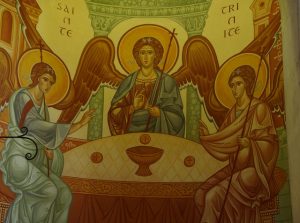Lectionary Reflection for Holy Trinity Sunday, Year B
May 31, 2015
Nicodemus said to him, “How can these things be?” John 3:9
Nicodemus’ question sounds logical enough, doesn’t it? After all, inquiring minds want to know. Now that we’ve had the celebration, joy, and excitement of Pentecost, we come to that lovely Sunday where the temptation is often to rehash and attempt to explain the truly inexplicable nature of God and the concept of the Trinity: One God in three persons. One God in three essences. One God in three expressions. Good luck with that!
And frankly, would you rather hear or preach a sermon about how to chip away at the notion of a mysterious, creative, powerful triune God and attempt to try to prove the improvable, or would you rather share the story of a Creator who so desires a relationship with humankind that God would give up the Son–God’s own self–so that we can avoid condemnation and have real, lasting, eternal life? Instead of trying to compare the triune God to any earthly thing, why not explore the  relational God who is always doing a new thing in, among, and through us? This is the God who blots out our sin, wraps us in love, and wants to be deeply involved in our lives.
relational God who is always doing a new thing in, among, and through us? This is the God who blots out our sin, wraps us in love, and wants to be deeply involved in our lives.
I would much rather share this story and not have all of the answers, have none of the control, yet have all of the promise, the amazing love, and the enduring relationship that’s found through Christ Jesus, by the power of the Holy Spirit, and because of the amazing Creator. Rather than trying to sneak up in the dark and figure things out, to then leave scratching my head and asking “How can these things be?” I’d rather holler to the high heavens “How can these things NOT be?!” and live in the bliss of my ignorance by the mighty gift of faith. Even on those days when my faith seems like a thin, fragile, fraying cord, I’ll still stake my claim on it rather than on trying to figure out how God is like a shamrock, or water/ice/steam.
This is the only way I can make sense of a confusing world. The idea of this mighty love of God–a love that destroyed death, that spoke everything into being, and that desires to have a real and meaningful relationship–this trumps reason every single time. What a lavish gift! What a mysterious gift! What a radical gift!
Our world needs to know that there is something more, that the church is a place where relationships can be forged deeply, where we can come and find–like the theme song from the television sitcom “Cheers”–a place where everyone knows your name. Most of all, our shattered, scattered, and suspicious world needs to see a  table where all are welcome and where a relational God meets us just as we are and equips us to be so much more through the work of the Spirit and in the name of Christ.
table where all are welcome and where a relational God meets us just as we are and equips us to be so much more through the work of the Spirit and in the name of Christ.
God is bigger, more complex, supremely powerful, and way beyond the limits of my simple human understanding, and that is just fine, thank you very much. On this day when we recognize the Holy Trinity and the relational power of God, I find that what I have is enough. In fact, it is much more than enough that the table is spread, the wine is poured, the bread is broken and all of God in divine fullness is present. How can this NOT be enough? How can these things NOT be? With God all things are possible. Go and tell this simply marvelous and ridiculously fantastic story.
In Worship
Consider projecting an image of Rublev’s Icon (image at left above) during worship today. If you don’t have projection capability, either reproduce a version on a bulletin insert, as the bulletin cover, or as a large poster where folks can easily see it. Invite them in small groups to gaze on the image. Invite them to share what they see, feel, and think. How might this image be lived out in your particular context? Where do you experience the fullness of God interacting and interwoven into the life of your congregation? How might you share that experience with others, or at least invite them to come and see for themselves?
With Youth
Invite the youth to “illustrate” Psalm 29. This psalm explores the nature of God through the psalmists eyes and experience. Encourage the youth to see it through their own eyes and cultural lenses. Maybe they want to rewrite some of the images. Consider a short film or PowerPoint presentation to share with the congregation.
With Children
Share the strange and wonderful story of the prophet’s call from this week’s Old Testament reading. The prophet feels like he is not worthy or prepared to for the work of a prophet. God has other ideas. He uses a hot coal to cleanse the prophet’s mouth and heart (Do NOT try this at home!).And then God calls out “Whom shall I send, and who will go for us?” The prophet, now prepared by God, says “Here am I; send me!” Tell the children they don’t need strange seraphs and hot coals because God met them in the water of baptism–named and claimed them and is in the process of equipping each one of them for ministry. Remind the children that all they have to do is say “Here am I; send me.” God will send them into the world to share the good news with others. Finish with a sort prayer.
(Photos: A. Davey and K.H. Rawlings, Creative Commons. Thanks!)




Leave a Reply